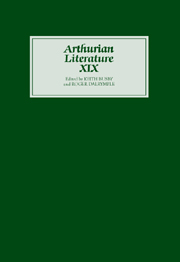Book contents
- Frontmatter
- Contents
- General Editor's Foreword
- I Comedy and Tragedy in Some Arthurian Recognition Scenes
- II Merveilleux et comique dans les romans arthuriens français (XIIe–XVe siècles)
- III La bande dessinée virtuelle du lion d'Yvain: sur le sens de l'humour de Chrétien de Troyes
- IV Convention, Comedy and the Form of La Vengeance Raguidel
- V Le comique dans Les Merveilles de Rigomer et Hunbaut
- VI Humour in the Roman de Silence
- VII La pratique de la ‘disconvenance’ comique dans le Lancelot en prose: les mésaventures amoureuses de Guerrehet
- VIII Lancelot Part 3
- IX Comic Functions of the Parrot as Minstrel in Le Chevalier du Papegau
- X Dinadan en Italie
- XI A Comical Villain: Arthur's Seneschal in a Section of the Middle Dutch Lancelot Compilation
- XII Malory and the English Comic Tradition
- XIII ‘Laughyng and Smylyng’: Comic Modalities in Malory's Tale of Sir Launcelot du Lake
- XIV The Eachtra an Amadáin Mhóir as a Response to the Perceval of Chrétien de Troyes
- CONTENTS OF PREVIOUS VOLUMES
XI - A Comical Villain: Arthur's Seneschal in a Section of the Middle Dutch Lancelot Compilation
Published online by Cambridge University Press: 05 February 2013
- Frontmatter
- Contents
- General Editor's Foreword
- I Comedy and Tragedy in Some Arthurian Recognition Scenes
- II Merveilleux et comique dans les romans arthuriens français (XIIe–XVe siècles)
- III La bande dessinée virtuelle du lion d'Yvain: sur le sens de l'humour de Chrétien de Troyes
- IV Convention, Comedy and the Form of La Vengeance Raguidel
- V Le comique dans Les Merveilles de Rigomer et Hunbaut
- VI Humour in the Roman de Silence
- VII La pratique de la ‘disconvenance’ comique dans le Lancelot en prose: les mésaventures amoureuses de Guerrehet
- VIII Lancelot Part 3
- IX Comic Functions of the Parrot as Minstrel in Le Chevalier du Papegau
- X Dinadan en Italie
- XI A Comical Villain: Arthur's Seneschal in a Section of the Middle Dutch Lancelot Compilation
- XII Malory and the English Comic Tradition
- XIII ‘Laughyng and Smylyng’: Comic Modalities in Malory's Tale of Sir Launcelot du Lake
- XIV The Eachtra an Amadáin Mhóir as a Response to the Perceval of Chrétien de Troyes
- CONTENTS OF PREVIOUS VOLUMES
Summary
In most Arthurian verse romances, it doesn't take long before Arthur's seneschal Keu comes into action. He usually appears as the static character that we have met in the romances of Chrétien de Troyes: a man of ancient nobility, devoted to his official duties. Yet he is irascible and grudging, suffering from what Ménard has called an ‘incontinence verbale’. It is no surprise at all that his appearance almost invariably triggers a conflictual episode in which he readily uses his sarcastic rhetoric to slander his fellow knights. Although his criticism is very sharp, in his mockery often an element of truth is found. Therefore, the humiliated heroes have to establish, or recover, their stained reputations in a series of adventures, which form the content of a lot of Arthurian romances.
The characterization of Keu in most romances (except for the Old French Yder and Perlesvaus) has comical overtones, especially when it comes to his insufficient achievements as far as knightly performance is concerned. Because of his official duties, he is tied to the Arthurian court, but when he sets off for an adventure in the outside world, he usually demonstrates his inadequacy in one or more monumental mesaventures, in which he is comically unhorsed, usually by the first stroke of the spear of his opponent. In his actions he serves as a faire-valoir for the knights with a better reputation, especially Gauvain. Where the latter succeeds, Keu must fail.
- Type
- Chapter
- Information
- Arthurian Literature XIXComedy in Arthurian Literature, pp. 165 - 176Publisher: Boydell & BrewerPrint publication year: 2002



